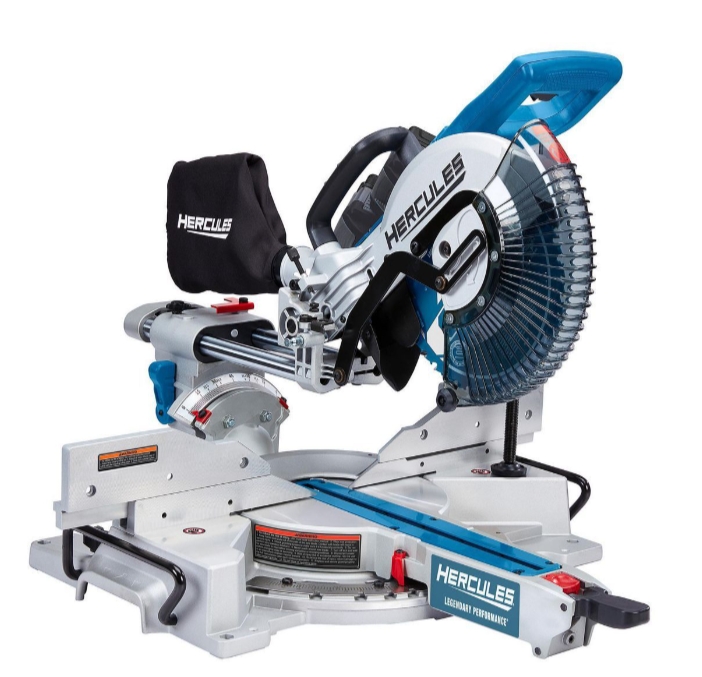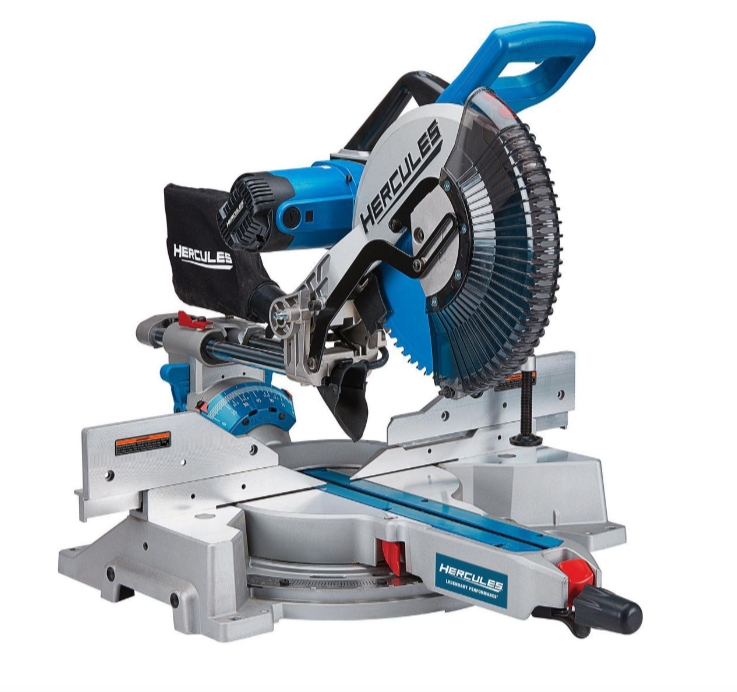
HERCULES 20V Brushless Cordless 10 in. Dual-Bevel Sliding Compound Miter Saw – Tool Only
- The HERCULES® 20V Brushless Cordless 10 in. Dual-Bevel Sliding Compound Miter Saw delivers true professional performance on the jobsite with large-dimensional lumber capacity, cutting boards up to 15-1/8 in. wide. The sliding head provides a crosscut capacity up to 3-9/16 in. x 12-1/8 in. (front fence) and 2-9/16 in. x 15-1/8 in. (rear fence). The 2-position fence handles nested crown molding up to 6-3/4 in.
- Fence system enables cuts in 2 locations, front fence and rear fence, for generous 15-1/8 in. horizontal cuts
- Integrated precision shadow guide system for accurate cuts
- High-output brushless motor delivers 4200 RPM for high-performance cutting
- Precision miter cuts from 0-50° L and 0-60° R
- Dual-bevel design, 0-48° L and R for a wide variety of cuts
- Electric brake stops blade to safely move from cut to cut
$299.99

HERCULES 12 in. Dual-Bevel Sliding Compound Miter Saw with Precision LED Shadow Guide
- The HERCULES® Professional 12 in. Dual Bevel Sliding Miter Saw was engineered to deliver Legendary Performance in your shop or on the jobsite. Designed with the same cutting capacity, precision, accuracy, and durability as the best-selling professional miter saws on the market. The HERCULES® Miter Saw is packed with features for the professional at an unbeatable price.
- 7-1/2 in. crown molding nested capacity
- 6-3/4 in. baseboard vertical capacity
- Precision Blade Guide System allows better visibility of cut line for accurate cuts every time
- High-output 15 amp, 4100 RPM motor delivers the power needed for high-performance cutting
- Adjustable stainless steel miter detent plate with 10 positive stops
- Miter detent override system for fine adjustments
- Double-bevel design with oversized bevel scale makes bevel-angle adjustments accurate and easy
- Miters 60° to the right and 50° to the left to accommodate a wide variety of cuts
- Free professional 60-tooth carbide-tipped saw blade included
$349.99
After fifteen years in woodworking and construction, I’ve had my hands on just about every miter saw on the market. When Harbor Freight introduced their Hercules line, promising professional-grade tools at budget-friendly prices, I was skeptical. But after six months of putting the Hercules Sliding Miter Saw through its paces on everything from delicate trim work to hefty hardwood beams, I’m ready to share my unfiltered experience. If you’re considering this saw for your workshop or jobsite, this comprehensive guide will help you decide if it’s the right fit for your needs and budget.
My First Impression
The day I brought home my Hercules Sliding Miter Saw, I was immediately struck by its solid construction. Weighing in at approximately 56 pounds, this isn’t a lightweight contender. The substantial heft speaks to its durability, though it does mean you’ll want to consider transportation carefully if you’re moving between jobsites.
Unboxing the saw revealed a machine that clearly takes design cues from industry leaders like DeWalt. The familiar yellow-and-black aesthetic has been replaced with Hercules’ blue and black color scheme, but the essential design elements feel reassuringly familiar. The Hercules Sliding Miter Saw represents remarkable value for money, offering professional-grade features at a price point that’s accessible to serious DIYers and budget-conscious contractors alike.
Technical Specifications: The Numbers That Matter
Before diving into performance, let’s get acquainted with the specifications that make the Hercules Sliding Miter Saw a contender in the crowded miter saw market:
- Model Number: 63978
- Power Source: Corded-electric, 15 Amp motor
- Blade Size: 12-inch carbide-tipped blade (included)
- Speed: 3,800 RPM (no-load)
- Bevel Capacity: Dual bevel, 0-48° left and right
- Miter Range: 0-50° left and right
- Maximum Cutting Capacity:
- 2×14 at 90° (dimensional lumber)
- 2×10 at 45° miter
- Crown molding: 6-5/8″ nested
- Baseboard: 4-1/4″ vertical
The saw comes pre-calibrated from the factory, and in my experience, the alignment was impressively accurate right out of the box. This saves valuable setup time and speaks to Harbor Freight’s quality control on their premium Hercules line.
Price Point: Value Proposition
Let’s address the elephant in the room—price. Currently retailing at around $399 (as of my last check), the Hercules Sliding Miter Saw positions itself in an interesting middle ground. It’s significantly more affordable than premium brands like DeWalt, Milwaukee, or Makita, whose comparable models often fetch $550-700. Yet it’s noticeably more expensive than budget options like Ryobi or Harbor Freight’s own lower-tier brands.
This pricing strategy is deliberate. Harbor Freight has positioned Hercules as their professional-grade line, designed to compete with the big names while maintaining a price advantage. After extensive use, I believe they’ve largely succeeded in hitting this sweet spot. The Hercules offers about 80-90% of the performance of premium brands at roughly 60-70% of the cost.
Is this the absolute cheapest sliding miter saw you can buy? No, but it’s among the most affordable options that I would confidently use for precision work or commercial projects. For many professionals and serious hobbyists, this represents an ideal balance of performance and value.
Where to Buy: Availability and Purchase Options
The Hercules line is exclusive to Harbor Freight, which means you won’t find these tools at big box stores like Home Depot or Lowe’s. Harbor Freight has over 1,000 stores across the United States, making physical locations accessible to most Americans. Their website also offers online ordering with shipping options, though given the weight of the saw, in-store pickup might be preferable to avoid shipping costs.
Harbor Freight frequently runs sales and promotions, and I’ve seen the Hercules Sliding Miter Saw discounted by as much as $50-75 during special events. They also offer an extended warranty program called “Hercules Protection Plan” which extends coverage beyond the standard warranty period for an additional fee.
One advantage of buying from Harbor Freight is their return policy, which generally allows returns within 90 days with a receipt. This generous window gives you ample time to test the saw on various projects and ensure it meets your needs.
Performance Analysis: Putting It Through Its Paces
Power and Capacity
The 15-amp motor is the standard for corded miter saws in this class, and it delivers respectable performance. At 3,800 RPM, it’s slightly slower than some premium competitors that reach 4,000+ RPM, but in practice, this difference is negligible for most applications.
Where the Hercules truly shines is in its cutting capacity. The sliding mechanism works smoothly, allowing for crosscuts up to 14 inches wide in standard dimensional lumber. This exceeds the capacity of many saws in its price range and even matches some premium models. For renovation work and construction projects where you’re frequently cutting wide boards, this extended capacity is a genuine advantage.
I recently completed a deck renovation that required cutting numerous 2×12 pressure-treated boards, and the Hercules handled them without bogging down. The slide mechanism remained smooth even after dozens of cuts in dense, wet lumber—a test that would challenge many saws in this class.
Precision and Accuracy
For a sliding miter saw in this price range, I was impressed by the accuracy out of the box. The factory calibration was within 0.2 degrees of perfect on both miter and bevel settings—a level of precision that exceeds what I’ve experienced with some more expensive brands.
The detents (preset stopping points) at common angles like 0°, 15°, 22.5°, 31.6°, and 45° engage with a satisfying click and hold the saw firmly in position. The miter lock mechanism is robust, with minimal play once locked in position. This translates to consistent, repeatable cuts—a must-have feature for trim work and finish carpentry.
One notable feature is the dual bevel capability, allowing the saw to tilt both left and right up to 48 degrees. This is especially valuable when cutting crown molding or complex trim pieces, as it eliminates the need to flip your workpiece—a convenience that saves time and reduces the risk of errors.
Laser Guide System
The Hercules Sliding Miter Saw comes equipped with a laser guide system that projects a red line onto your workpiece, indicating where the blade will cut. Unlike some cheaper implementations that can be wildly inaccurate, the Hercules laser is adjustable and, once properly calibrated, provides a reliable cutting line.
I initially had mixed feelings about laser guides, having found them more gimmicky than useful on some tools. However, the implementation on the Hercules is practical and helpful, especially when making quick cuts in dimly lit environments. The laser activates when the saw is powered on, though there’s no separate switch to operate it independently of the motor—a minor inconvenience but not a dealbreaker.
Dust Collection
Dust collection is typically a weak point for most miter saws, and the Hercules is no exception. The included dust bag captures perhaps 60-70% of the dust generated during cutting—better than nothing, but far from perfect. I’ve connected the dust port to my shop vacuum using an adapter, which improves collection efficiency significantly.
For workshop use, I recommend setting up a proper dust extraction system if you’ll be making numerous cuts, particularly with MDF or other materials that produce fine dust. For jobsite use, the included dust bag is adequate for basic dust management, but expect some cleanup afterward.
Ergonomics and User Experience
Controls and Adjustments
The bevel adjustment on the Hercules requires reaching to the back of the saw, which is standard for most miter saws but can be slightly awkward, especially when the saw is positioned against a wall. The bevel scale is clearly marked and easy to read, with positive stops at 0° and 45° in both directions.
Adjusting the miter angle is straightforward, with a large knob at the front of the saw that loosens and tightens the miter table. The scale is well-marked with clear numerals, and the detent override allows you to make fine adjustments near common angles without the saw snapping into the preset detents.
The handle features a soft-grip coating that remains comfortable during extended use, and the trigger mechanism operates smoothly. The blade guard is transparent, allowing good visibility of the cutting line, and retracts smoothly as you lower the blade.
Safety Features
Safety is paramount with any power tool, and the Hercules includes standard safety features like:
- An electric blade brake that stops the blade within seconds of releasing the trigger
- A transparent blade guard that automatically retracts during cutting
- A blade guard lock that prevents accidental lowering of the saw
- A trigger safety that must be disengaged before the saw can be operated
These features are well-implemented and don’t feel intrusive during normal operation—a balance that not all manufacturers achieve successfully.
Comparisons: How Does It Stack Up?
Hercules vs. DeWalt
DeWalt is often considered the gold standard in jobsite miter saws, so this comparison is inevitable. The comparable DeWalt model (DWS780) typically retails for around $600-700, making it significantly more expensive than the Hercules.
In terms of performance, the DeWalt has a slight edge in power, precision, and dust collection. Its XPS shadow line cutting guide also outperforms the Hercules’ laser guide in terms of accuracy and visibility in varying light conditions.
However, these advantages come at a substantial price premium. For many users, the question becomes whether these incremental improvements justify spending an additional $200-300. In my experience, unless you’re a high-volume professional who will use the saw daily for years, the Hercules offers better value.
Hercules vs. Milwaukee
Milwaukee’s 12″ sliding compound miter saw competes in the premium segment, typically priced around $600. Like DeWalt, Milwaukee offers marginally better build quality and slightly smoother operation than the Hercules.
The Milwaukee saw features better dust collection and a more robust fence system. However, the cutting capacity is comparable to the Hercules, and in day-to-day operation, the performance difference may not justify the price gap for many users.
The Milwaukee does offer better integration with their ecosystem of tools if you’re already invested in their batteries and accessories, but for a corded miter saw, this advantage is less significant.
Hercules vs. Other Harbor Freight Options
Harbor Freight offers several miter saws across different price points, including their budget-oriented Chicago Electric and Admiral lines. The Hercules represents a significant step up from these options in terms of build quality, accuracy, and features.
While you might save $150-200 by opting for a lower-tier Harbor Freight saw, the precision, durability, and capacity of the Hercules make it worth the premium for anyone who values accuracy and reliability. The budget options are adequate for occasional use or rough carpentry, but for finish work or daily use, the Hercules is the clear choice within the Harbor Freight lineup.
Suitability for Different Users
Professional Contractors
For professional contractors, the value proposition of the Hercules is compelling. While it may not match the absolute premium feel of top-tier DeWalt or Milwaukee saws, the performance-to-price ratio is excellent. If you’re a contractor managing costs on tight-margin jobs, the Hercules can free up budget for other tools without significantly compromising capability.
I’ve spoken with several contractors who use the Hercules as their “second saw”—keeping a premium model in the shop and using the Hercules on jobsites where theft or damage is a concern. This approach makes economic sense and speaks to the saw’s credibility among professionals.
Fine Woodworking and Precision Work
For fine woodworking, precision is paramount. The Hercules offers surprisingly good accuracy, especially after taking time to verify and fine-tune all alignments. I’ve used it for crown molding, picture frames, and furniture components with satisfactory results.
That said, dedicated woodworkers who demand the absolute pinnacle of precision might still prefer a higher-end saw or a specialized tool like a Festool Kapex. The Hercules is accurate enough for most fine woodworking, but the most exacting projects might reveal its limitations.
DIY and Home Users
For DIY enthusiasts and homeowners, the Hercules represents perhaps more saw than you need—but it’s an investment that will serve you well for years. If your budget allows and you anticipate tackling ambitious home renovation projects, the Hercules offers professional capability at a price point that’s within reach for serious hobbyists.
The capacity to handle 14″ crosscuts and the dual bevel feature make it versatile enough for virtually any home improvement project, from deck building to crown molding installation. However, if you’re only making occasional cuts or working on simple projects, a less expensive miter saw might be more appropriate.
Maintenance and Longevity
Blade Replacement and Maintenance
The Hercules comes with a 12″ carbide-tipped blade that’s adequate for general purpose cutting, but investing in a higher-quality blade can significantly improve cut quality, especially for finish work.
Replacing the blade is straightforward:
- Unplug the saw (always the first step!)
- Remove the blade guard cover screw
- Retract the lower blade guard
- Press the spindle lock button
- Use the included wrench to loosen the blade bolt (note that it has a left-hand thread)
- Remove the outer blade washer and blade
- Install the new blade, ensuring the rotation arrow matches the saw’s direction
- Replace the washer and bolt, and tighten securely
- Reinstall the blade guard cover
I recommend cleaning the blade regularly with a purpose-made blade cleaner to remove pitch and resin buildup, which can affect cutting performance and put strain on the motor.
Long-term Durability
The Hercules line has only been around for a few years, so long-term data is limited. However, based on construction quality and my experience with similar tools, I would expect a lifespan of 5-10 years with regular use, possibly longer with proper maintenance and care.
The slide mechanism is a potential wear point on any sliding miter saw. Keeping the slides clean and occasionally applying a dry lubricant (avoid oil-based lubricants that can attract dust) will help maintain smooth operation.
Warranty and Support
Harbor Freight offers a 90-day satisfaction guarantee and a 2-year limited warranty on Hercules power tools. This is less than the 3-5 year warranties offered by premium brands, but still reasonable for the price point.
The extended “Hercules Protection Plan” can increase coverage to 3 years for an additional cost (typically around $50 for this saw). Whether this represents good value depends on your risk tolerance and how hard you plan to use the tool.
Customer service experiences with Harbor Freight can be mixed, but they’ve been improving as they position themselves as a more serious tool retailer. Having all warranty service handled through Harbor Freight stores simplifies the process compared to manufacturers that require shipping tools to service centers.
Accessories and Enhancements
Available Accessories
While the Hercules ecosystem doesn’t offer as many dedicated accessories as brands like DeWalt, standard accessories like miter saw stands, aftermarket fences, and stop blocks are compatible.
The saw does not come with a stand, which is typical for saws in this class. Harbor Freight sells a compatible folding stand for around $99, which is reasonably sturdy and includes wheels for mobility. Alternatively, any standard miter saw stand should work, or you can build a custom station for workshop use.
Additional clamps can improve workpiece stability, especially when cutting smaller pieces. The Hercules comes with one material clamp, but adding a second clamp can be beneficial for certain cuts.
Aftermarket Upgrades
The most impactful upgrade for any miter saw is a premium blade. Investing $60-80 in a high-quality Freud or Diablo blade with appropriate tooth count for your typical materials can transform cut quality.
For dust collection, aftermarket adapters can improve compatibility with various shop vacuum systems. Some users have successfully modified the dust port to accept standard 2.5″ vacuum hoses, greatly enhancing dust capture efficiency.
LED work lights can be added to improve visibility, especially if you frequently work in dimly lit areas. Simple adhesive LED strips with battery power can be attached to the upper arm of the saw, providing illumination without interfering with operation.
Real-World Applications
Crown Molding and Trim Work
The Hercules excels at crown molding work thanks to its dual bevel capability and nested crown capacity of 6-5/8″. This allows you to cut even large crown molding profiles in their nested position, which is generally easier and more accurate than laying the molding flat.
The detent at 31.6° (the common crown molding angle) is precise and locks firmly, simplifying the somewhat complex process of cutting crown. I recently completed a living room renovation that involved installing crown throughout, and the Hercules performed flawlessly across dozens of cuts in hardwood molding.
Framing and Construction
For framing work, the high capacity of the Hercules is a significant advantage. Being able to cut 2×14 lumber at 90° and 2×10 at 45° means you can handle even large dimensional lumber without flipping the board.
The power is sufficient for continuous cutting of construction lumber, though as with any 15-amp saw, letting the blade come to full speed before entering the cut will produce the best results and reduce strain on the motor.
Hardwood and Dense Materials
When it comes to dense hardwoods like oak, maple, or exotic species, the Hercules handles them well, though feed rate becomes important. Slower, more controlled cuts yield better results in these materials.
I recently worked with some 8/4 maple for a tabletop project, and the Hercules cut cleanly with minimal tearout when paired with an appropriate blade. The motor showed no signs of strain, though I did notice the saw working harder than with softer woods.
Practical Tips from Experience
Getting the Most from Your Hercules
After months of regular use, I’ve developed some practices that help maximize the performance of the Hercules Sliding Miter Saw:
- Verify calibration periodically: Even if perfect out of the box, vibration and use can affect alignment. Check square with a reliable combination square and adjust as needed.
- Use the sliding function properly: For narrow cuts, lock the rails and use the saw like a standard compound miter saw. Only use the sliding function when necessary for wider boards.
- Support long workpieces properly: Inadequate support can cause binding and inaccurate cuts. Use roller stands or build extension wings for your miter saw station.
- Let the blade do the work: Don’t force the saw through cuts. A steady, controlled pressure yields cleaner results and extends motor life.
- Clean regularly: Dust buildup can affect precision and cause premature wear. A quick cleanup after each use pays dividends in longevity.
The Verdict: Is the Hercules Right for You?
After thoroughly testing and using the Hercules Sliding Miter Saw across numerous projects, I can confidently say it represents excellent value for money. It delivers professional-level performance in most aspects while maintaining a price point that’s accessible to serious DIYers and budget-conscious professionals.
Is it the absolute best sliding miter saw on the market? No—premium brands still offer marginal advantages in refinement, dust collection, and warranty. But is it the best value in its class? Quite possibly, especially for users who prioritize cutting capacity and accuracy over brand prestige.
The Hercules stands as compelling evidence that Harbor Freight’s push upmarket is genuine. This isn’t merely a budget tool with a premium price tag—it’s a legitimately capable saw that can hold its own against much more expensive competitors in real-world applications.
For professionals looking to equip multiple crews without breaking the bank, DIYers seeking professional capabilities without professional prices, or anyone who appreciates value without compromising on essential performance, the Hercules Sliding Miter Saw deserves serious consideration.
As with any tool purchase, consider your specific needs, budget, and how the tool will be used before making a decision. But if you do choose the Hercules, I suspect you’ll be as pleasantly surprised by its capabilities as I was. The Hercules Sliding Miter Saw represents remarkable value for money, offering professional-grade features at a price point that’s accessible to serious DIYers and budget-conscious contractors alike.
What’s your experience with the Hercules line or sliding miter saws in general? I’d love to hear your thoughts and questions in the comments below!







